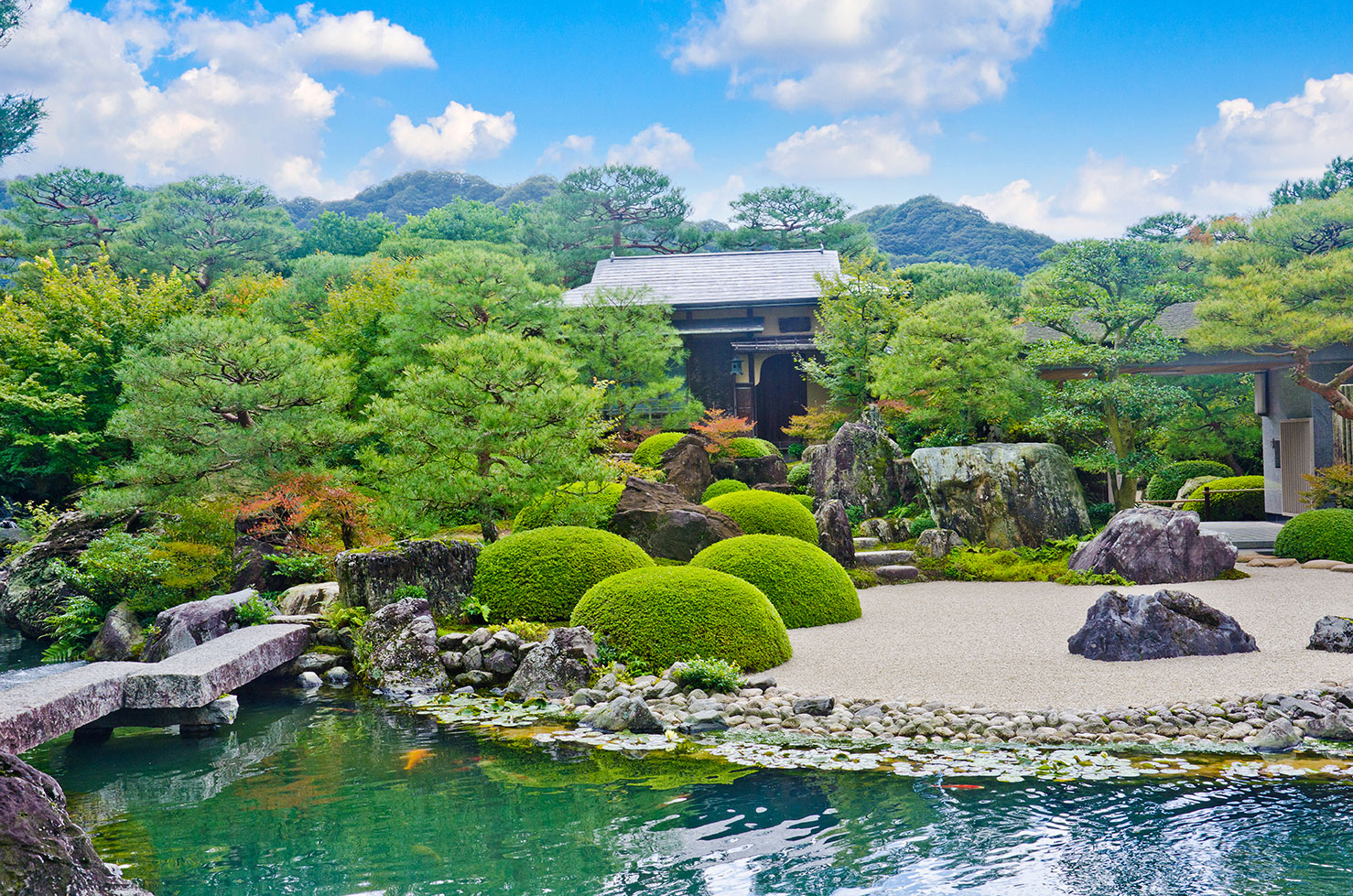

A JAPANESE GARDEN – THE LAND OF THE RISING SUN IN A NUTSHELL
The characteristics of the Japanese garden
Japanese gardens of all type are characterised by undemonstrative simplicity, sophisticated elegance and meticulous workmanship. The compositions are harmonious and, at the same time, asymmetrical – the plants and decorative elements should be odd in number, to reflect as much as possible the asymmetry present in nature. A Japanese garden is, in fact, a miniature of a natural landscape. Therefore, it is frequently arranged in a way which introduces diverse terrain, streams and ponds, and the appropriate use of stones and plants. The compositions usually take the shape of a triangle. Balance and harmony are provided by the combination of straight lines, which symbolise calmness and tension, and curved lines, neutralising tensions in the composition. The principles of garden design are inseparably connected with philosophy and religion (Shintoism, Buddhism, Taoism), and thanks to the spiritual element, the gardens in question become a perfect place for meditation and tranquillity.
The symbolism of the Japanese garden
The symbolic meaning of the elements of the Japanese garden concerns mainly natural elements. The symbolism of stones refers to their constancy, invariability and eternity. Each and every boulder should be similar in colour, shape and texture. Their arrangement should resemble, as much as possible, the natural distribution of stones in nature. Water, which brings movement and life into the garden and symbolises vigor, is a very important element. A calm stream corresponds to the feminine nature, while a swift stream or cascade of a waterfall symbolise a man. Colourful koi, in many varieties with different patterns and scales, can be often found swimming in ponds. The permanent (boulders) and variable elements (water) are complemented by plants, among which the colour green, which symbolises longevity, predominates. Colourful flowers are used one at a time.
The decorative elements also have a symbolic meaning. Stone lanterns refer to the four elements: earth, water, fire and wind. They came from China more than a thousand years ago, and at the time they were made from metal and used to illuminate temple entrances. Only later did they become made of stone and used in gardens, where they were used to illuminate the whole place.
Statues of lions and lionesses guard garden entrances. These animals symbolise two forces – yin and yang, and together they guard the space from uninvited guests. The shishi-odoshi bugaboos also serve this role. Shishi-odoshi is a type of water fountain consisting of a bamboo tube through which water from the pond flows. After becoming filled with water, the tube tilts and returns to its previous position, making a characteristic sharp sound. This sound is intended to deter herbivores such as wild boars, deer and roe deer, which can destroy the garden in search of food. In addition, the fountain has a symbolic meaning, as the water flowing through it refers to the passage of time.
The most popular plants in Japanese gardens
The plants growing in the Japanese garden should appear wild. Human influence should be unnoticeable. Choose small, even dwarf varieties of trees and shrubs. The quantity of species should be limited to several types. Evergreen plants, such as specially formed pines, junipers and other coniferous species, which, when appropriately bent, resemble bonsai in shape, are the most characteristic of Japanese gardens. Charming palmate maples and cherries, which are species native to Japan, are also noteworthy. In addition to trees, flower bushes, such as magnolias, are also planted to beautifully perk up the garden’s greenery.
The types of Japanese gardens
Japanese gardens differ in aesthetic and functional terms. Tsukiyama, loosely translated as a “miniature, artificial hill”, is one of the fundamental styles. It has small hills and stones which symbolise mountains, as well as ponds which resemble seas and lakes. The most famous gardens of this type are the gardens around the Silver and Golden Pavilions in Kyoto.
Karesansui, or a “dry landscape” garden, is another popular type. Its architecture is strongly influenced by the idea of Zen, and emphasises the dominance of civilization over nature. This is why you will not find virtually any plants here. Such a garden refers to the natural landscape in a more abstract way, with the whole composition being made primarily of stones. The emptiness between them is more important than the elements themselves. The water is symbolically represented by gravel and sand, and raking these imitates the waves hitting the shore. The boulders correspond to real islands. The most popular garden of this type is located by the Zen Temple in Kyoto.
A tea garden is characterised by intimacy and provides visitors with the opportunity to relax comfortably in the open. Their primary function is to create a place for the ritual of tea brewing. In front of the tea room there is a basin where guests can wash themselves before the ceremony.
Gardens also differ in size. A promenade garden must be large enough to constitute an excuse for a relaxing stroll. It has many scenes and its layout encourages you to go deeper and discover new views. A courtyard garden is its opposite, and spans on a small area. Its compact form results in it being established primarily to admire its composition and elements such as ponds, lanterns and bridges, which are more decorative than functional.
Most Japanese gardens are found in private homes and parks, as well as near temples and monuments. We encourage you to develop parts of your garden in an oriental style based on our tips. However, if you do not want to engage in garden design and do not have the time to take care of it, you can always go sightseeing even without flying to Japan to do so! You can find beautiful Japanese gardens in Wrocław in Szczytnicki Park (a garden from the early 20th century) and in Łódź, where a garden of this type forms part of the north-eastern wing of the Łódź Botanical Garden.














